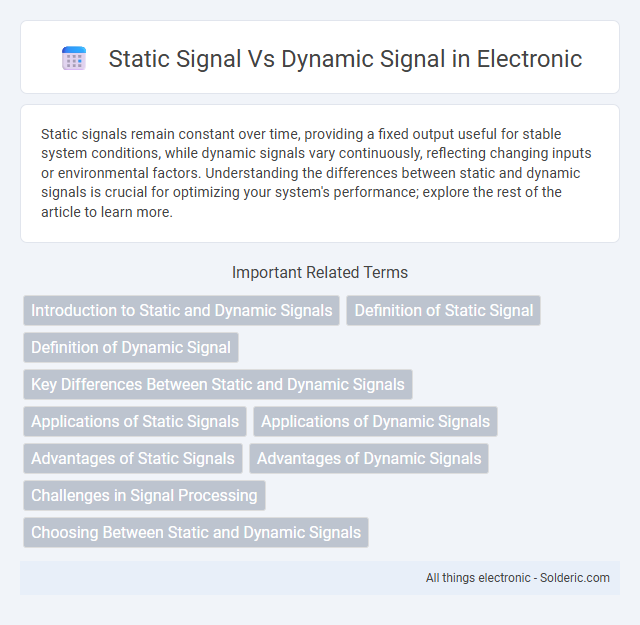Static signals remain constant over time, providing a fixed output useful for stable system conditions, while dynamic signals vary continuously, reflecting changing inputs or environmental factors. Understanding the differences between static and dynamic signals is crucial for optimizing your system's performance; explore the rest of the article to learn more.
Comparison Table
| Aspect | Static Signal | Dynamic Signal |
|---|---|---|
| Definition | Constant signal value over time | Signal value changes over time |
| Example | DC Voltage | AC Voltage |
| Frequency | Zero frequency (steady) | Non-zero frequency (varies) |
| Applications | Biasing circuits, Reference voltage | Communication signals, Sensors |
| Signal Behavior | No variation with time | Continuous variation with time |
| Analysis | Simple, no time dependency | Complex, time-dependent methods needed |
| Energy Content | Constant energy | Variable energy |
Introduction to Static and Dynamic Signals
Static signals maintain a constant value or level over time, representing fixed information such as a steady voltage or a constant digital bit. Dynamic signals vary continuously or change states periodically, conveying real-time data, examples include audio waves or fluctuating sensor outputs. Understanding how static signals provide stability while dynamic signals offer adaptability helps you optimize communication and processing systems effectively.
Definition of Static Signal
A static signal refers to a fixed, unchanging electrical or data signal that maintains a constant value over time, commonly used in digital circuits to represent a specific logic state such as binary 0 or 1. Unlike dynamic signals, static signals do not vary with time or external stimuli, ensuring stable and reliable communication within electronic systems. Understanding static signals helps you design consistent and noise-resistant signal processing applications.
Definition of Dynamic Signal
A dynamic signal refers to a time-varying electrical or electromagnetic signal that continuously changes in amplitude, frequency, or phase to convey information. Unlike static signals, which remain constant or unchanging over time, dynamic signals represent real-time data with varying characteristics essential for communication systems, control processes, and signal processing applications. Examples include audio signals, video transmissions, and sensor outputs that require continuous modulation and analysis.
Key Differences Between Static and Dynamic Signals
Static signals maintain a constant value over time, representing fixed or unchanging information, while dynamic signals vary continuously or discretely, reflecting real-time changes in the system or environment. Key differences include their temporal characteristics, with static signals being time-invariant and dynamic signals time-variant, and their applications, as static signals are commonly used in settings requiring stable references, whereas dynamic signals are essential for monitoring, control, and adaptive processes. Understanding these distinctions helps you design and interpret systems involving signal processing more effectively.
Applications of Static Signals
Static signals, characterized by their unchanging amplitude and frequency over time, are widely used in applications such as calibration of measurement instruments, where stable reference signals ensure accuracy. They serve a crucial role in digital logic circuits as fixed logic levels representing binary states 0 or 1. Additionally, static signals facilitate communication in control systems by providing constant signals to maintain system stability and monitoring.
Applications of Dynamic Signals
Dynamic signals are essential in applications such as communication systems, vibration analysis, and biomedical monitoring, where continuous real-time data tracking is crucial. They enable accurate detection and characterization of time-varying phenomena like audio waves, seismic activity, and heart rate variability. Their adaptability makes them ideal for dynamic environments requiring constant signal updates and analysis.
Advantages of Static Signals
Static signals offer the advantage of simplicity and consistency, making them easier to analyze and predict due to their unchanging nature over time. Their fixed properties reduce processing complexity, leading to lower computational requirements and increased reliability in systems such as digital communications and control devices. You benefit from enhanced stability and reduced noise interference when working with static signals in applications requiring precise measurement and control.
Advantages of Dynamic Signals
Dynamic signals offer superior adaptability by continuously updating to reflect real-time changes in the environment, enhancing accuracy in control systems and communications. They improve system responsiveness and efficiency by adjusting to varying conditions, reducing the risk of errors associated with fixed parameters in static signals. Dynamic signals are essential in applications requiring real-time monitoring, such as smart grids and adaptive filtering, where flexibility and timely data are critical for optimal performance.
Challenges in Signal Processing
Static signals present challenges in signal processing due to their fixed characteristics, which can lead to difficulties in detecting subtle changes or anomalies over time. Dynamic signals require advanced algorithms to track continuous variations and adapt to non-stationary properties, increasing computational complexity. Both static and dynamic signals demand robust noise reduction and feature extraction techniques to ensure accurate interpretation and analysis.
Choosing Between Static and Dynamic Signals
Choosing between static and dynamic signals depends on application requirements such as update frequency and resource constraints. Static signals maintain constant values, ideal for data that rarely changes, offering lower processing overhead and simpler implementation. Dynamic signals adapt in real-time, providing flexibility for scenarios requiring continuous monitoring, though they demand higher computational resources and complexity.
Static signal vs dynamic signal Infographic

 solderic.com
solderic.com